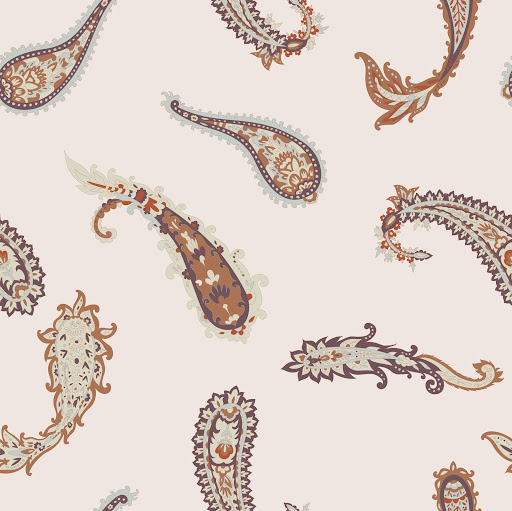As an arts and crafts enthusiast with a deep passion for patterns, I’ve always been drawn to the intricate beauty of paisley. This timeless design, with its distinctive teardrop shape and swirling motifs, has captivated artists and designers for centuries. Today, I want to take you on a journey to rediscover the allure of traditional paisley art and explore its relevance in modern crafting.
The Rich History of Paisley
Originating in Persia, the paisley pattern has a history dating back over 2,000 years. It gained popularity in the West during the 18th and 19th centuries, particularly in the Scottish town of Paisley, from which it derives its modern name. The pattern’s intricate details and versatility have ensured its enduring appeal across cultures and time periods.
Initially, paisley designs were woven into luxurious Kashmir shawls, prized possessions among the elite. As demand grew, European weavers, especially those in Paisley, Scotland, began producing imitations, leading to the pattern’s widespread popularity and its eventual name.
The Symbolic Meaning
Beyond its aesthetic appeal, paisley carries deep symbolism. In many cultures, it represents life and eternity, with the teardrop shape often interpreted as a sprouting seed or a symbol of fertility. This rich symbolism adds layers of meaning to the already visually stunning pattern.
In Persian culture, the paisley shape, known as “boteh” or “buta,” is believed to represent a floral spray combined with a cypress tree, a Zoroastrian symbol of life and eternity. In India, it’s often associated with the mango, a symbol of fertility and abundance.
The Anatomy of Paisley
Understanding the structure of paisley can help in appreciating and creating it:
- The Teardrop: The main body of the paisley, often filled with intricate designs.
- The Curl: The characteristic curve at the top of the teardrop.
- The Spine: The central line running through the teardrop.
- The Fill: The intricate patterns inside the teardrop, can include floral motifs, geometric shapes, or abstract designs.
Incorporating Paisley in Modern Crafts
As a crafter, I find endless inspiration in paisley. Here are some ways you can incorporate this beautiful pattern into your own projects:
- Fabric printing: Create your own paisley-patterned textiles using block printing techniques. Carve a paisley design into a linoleum block and experiment with different colour combinations on the fabric.
- Embroidery: Embroider paisley designs on pillowcases, clothing, or wall hangings. Try using different stitches to add texture and depth to your paisley patterns.
- Paper crafts: Use paisley in scrapbooking, card making, or as a motif in origami. You can create beautiful paisley-themed greeting cards or use paisley-patterned papers in your scrapbook layouts.
- Painting: Explore paisley in various painting mediums, from watercolours to acrylics. Try creating a large-scale paisley artwork for a striking wall piece.
- Digital art: Use graphic design software to create paisley patterns for digital projects or to design patterns for print-on-demand products.
- Quilting: Incorporate paisley patterns into your quilt designs, either through appliqué or by using paisley-printed fabrics.
The Meditative Aspect of Paisley Art
One of the things I love most about working with paisley is its meditative quality. The repetitive yet intricate nature of creating paisley patterns can be incredibly calming and centring. It’s a perfect way to practice mindfulness while creating something beautiful.
When I sit down to draw or paint paisley patterns, I often find myself entering a state of flow. The process of creating each curve and filling in the intricate details requires focus and patience, allowing me to disconnect from daily stresses and immerse myself in the art.
Paisley in Contemporary Fashion and Design
While paisley has deep historical roots, it continues to be a relevant and popular pattern in modern design. Fashion designers regularly incorporate paisley into their collections, from subtle accents to bold, all-over prints. In interior design, paisley can add a touch of elegance and complexity to spaces through wallpapers, upholstery, or decorative objects.
The versatility of paisley allows it to adapt to various styles:
- Bohemian: Large, colourful paisley prints for a free-spirited look.
- Modern: Simplified, geometric paisley patterns for a contemporary feel.
- Classic: Traditional paisley in muted tones for timeless elegance.
- Eclectic: Mixing paisley with other patterns for a bold, unique style.
Tips for Creating Your Own Paisley Designs
If you’re inspired to create your own paisley patterns, here are some tips to get you started:
- Start with the basic teardrop shape and build from there.
- Experiment with different scales – mix large and small paisley motifs.
- Play with colour combinations to create different moods and effects.
- Don’t be afraid to incorporate other elements like flowers or geometric shapes into your paisley design.
- Practice drawing the curved lines of paisley to develop fluid, natural-looking shapes.
Conclusion
Rediscovering traditional paisley art has been a journey of creativity and cultural exploration for me. This timeless pattern offers endless possibilities for artistic expression and continues to inspire designers and crafters around the world. Whether you’re drawn to its rich history, symbolic meaning, or simply its aesthetic beauty, paisley has something to offer every creative soul.
I encourage you to delve into this beautiful pattern, whether through crafting, studying its history, or simply appreciating its presence in art and design around you. The world of paisley is vast and endlessly fascinating – there’s always something new to discover!
As you explore paisley in your own creative endeavours, remember that it’s not just about replicating a pattern, but about connecting with a rich artistic tradition and making it your own. Let the flowing lines and intricate details of paisley inspire you to create something truly unique and beautiful.
Written by Alan Boal Paisley

